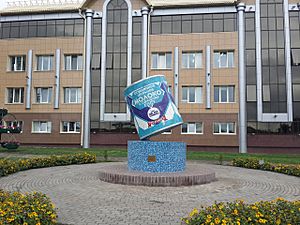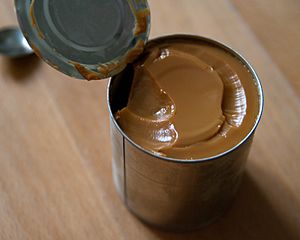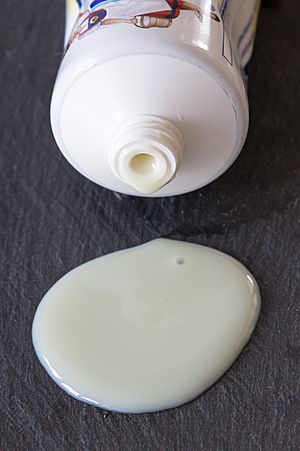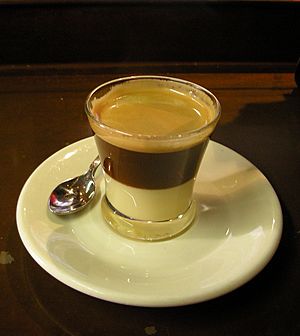Condensed milk facts for kids
Condensed milk is a special kind of cow's milk that has had most of its water removed – about 60% of it! It's usually found with lots of sugar added, and this is called sweetened condensed milk. In fact, when people say "condensed milk," they often mean the sweet kind. Sweetened condensed milk is very thick and sweet. When it's put into a can, it can stay good for many years without needing a fridge, as long as the can isn't opened. People use this sweet, creamy product in many different desserts all over the world.
There's also a similar product called evaporated milk. It's also had water removed, but it's not sweetened. Evaporated milk goes through a longer process to keep it fresh because it doesn't have sugar to help preserve it. Both condensed milk and evaporated milk have about the same amount of water taken out.
Contents
The Story of Condensed Milk

People have been trying to make milk last longer for a very long time! In the 1200s, a famous explorer named Marco Polo wrote that the Tatars (a group of people from Asia) knew how to make milk thicker. He said each person carried about 10 pounds (4.5 kg) of milk paste, which they could mix with water to make a drink. However, this was probably a type of fermented milk, like a soft cheese, not the fresh condensed milk we know today.
Early Attempts and Gail Borden's Idea
In France, in 1820, a man named Nicolas Appert also worked on condensing milk. But the real breakthrough came in the United States in 1853, thanks to Gail Borden Jr.. He wanted to find a way to store milk for more than just a few hours. Back then, fresh milk was only available if you lived very close to a cow.
Gail Borden had a sad experience in 1851. He was coming back from a trip to England, and several children on his ship died. It seemed they got sick from bad milk from the cows on board. Even though Borden didn't have much schooling, he was determined to find a solution. He got an idea from seeing a "vacuum pan" used by a group called the Shakers. This machine could remove water from fruit juice without burning it. Borden managed to use a similar idea to reduce milk without scorching or curdling it.
His first two factories didn't work out, but his third one, built with a new partner named Jeremiah Milbank in Wassaic, New York, was a success! This factory finally made a milk product that lasted a long time and didn't need to be kept cold.
Borden's Rules for Clean Milk
Gail Borden also made sure the milk he used was very clean. He had strict rules for farmers who wanted to sell him raw milk. These rules, sometimes called the "Dairyman's Ten Commandments," included:
- Washing the cows' udders before milking.
- Keeping barns clean.
- Cleaning and drying milk strainers every morning and night.
By 1858, Borden's milk, sold as Eagle Brand, became known for being pure, long-lasting, and affordable.
Growth and Challenges
In 1864, Borden's company, the New York Condensed Milk Company, built a huge factory in Brewster, New York. It was the biggest and most advanced milk factory of its time. Over 200 dairy farmers supplied 20,000 gallons (76,000 liters) of milk every day! Demand for condensed milk grew a lot during the American Civil War. The U.S. government bought huge amounts of it for soldiers. It was a great food for soldiers because a small can had a lot of calories and nutrients.
After the war, soldiers went home and told everyone about condensed milk. By the late 1860s, it was a very popular product. Factories started opening in other places, like Canada in 1871. However, by 1912, too many companies were making condensed milk, and there was too much of it. This caused prices to drop, and many factories had to close.
Improving Production
In 1914, Otto Frederick Hunziker, who was in charge of the dairy department at Purdue University, wrote an important book called Condensed Milk and Milk Powder. This book, along with his other work, helped make the way condensed milk was made much better and more standard, both in the U.S. and around the world.
The First World War (1914-1918) made condensed milk popular again. Its ability to be stored for a long time and easily transported was very helpful during the war.
How Condensed Milk is Made
Making condensed milk starts with fresh milk. First, the milk is cleaned and adjusted so it has the right amount of fat. Then, it's heated to a very high temperature (about 85–90°C or 185–194°F) for a few seconds. This heating process does a few important things:
- It kills some tiny living things (microorganisms) that could spoil the milk.
- It helps prevent the fat from separating.
- It stops the milk from oxidizing (which can change its flavor).
Next, some of the water is evaporated (removed) from the milk. After that, sugar is added until there's almost an equal amount of sugar and milk. This sugar is super important because it helps the sweetened condensed milk last a long time. The sugar increases the liquid's osmotic pressure, which means it makes it harder for tiny germs to grow and spoil the milk. Finally, the sweetened, evaporated milk is cooled, and tiny lactose crystals are formed.
Where is Condensed Milk Used Today?

Condensed milk is a popular ingredient in many yummy foods and drinks around the world!
Desserts and Sweets
- In Brazil, it's the main ingredient in a candy called brigadeiro.
- It's used in famous desserts like key lime pie and caramel candies.
- In the United Kingdom, it's sometimes mixed with clotted cream to make fudge.
- Borden's Eagle Brand company even showed how easy it is to make ice cream at home with their product, cream, and flavorings.
- In New Orleans, it's a common topping for chocolate snowballs (a type of shaved ice dessert).
- In Scotland, it's boiled with sugar and butter to make a sweet candy called tablet.
- In the Southern U.S., it's a key ingredient in lemon ice box pie.
- In the Philippines, it's mixed with evaporated milk and eggs to make leche flan, a type of caramel custard.
- In Mexico, it's used in a cold cake dessert, often with Marie biscuits and lemon juice.
- In Brazil, it's used in desserts like pavê or torta de bolacha.
- You can make homemade dulce de leche (a thick caramel sauce) by baking or boiling a can of condensed milk. In Brazil, this is called doce de leite.
- In Britain and Ireland, it's a layer in Banoffee pie.
- In Kent, England, it's used in a pastry called Gypsy tart.
- In Latin American countries, it's a key ingredient in tres leches cake (three milks cake).
- In Russia and Poland, people traditionally boil a can of condensed milk to make a sweet, caramel-like spread called varionaya sguschyonka, similar to dulce de leche.
Drinks
- In parts of Asia and Europe, sweetened condensed milk is often added to coffee or tea.
- Many countries in Southeast Asia, like Vietnam and Cambodia, use it to flavor their hot or iced coffee.
- In Malaysia and Singapore, a popular tea drink called teh tarik is made with condensed milk.
- It's an important part of Hong Kong tea culture.
- In the Canary Islands, it's served in a special coffee called café cortado.
- In Valencia, Spain, it's used in a café bombón.
Making Your Own Condensed Milk
If you don't have condensed milk, you can make it at home!
- You can mix one cup of evaporated milk with one and a quarter cups of sugar in a saucepan. Heat and stir until the sugar is fully dissolved, then let it cool.
- Another way is to gently cook regular milk and sugar together until the milk has reduced by about 60%.
See also
 In Spanish: Leche condensada para niños
In Spanish: Leche condensada para niños



